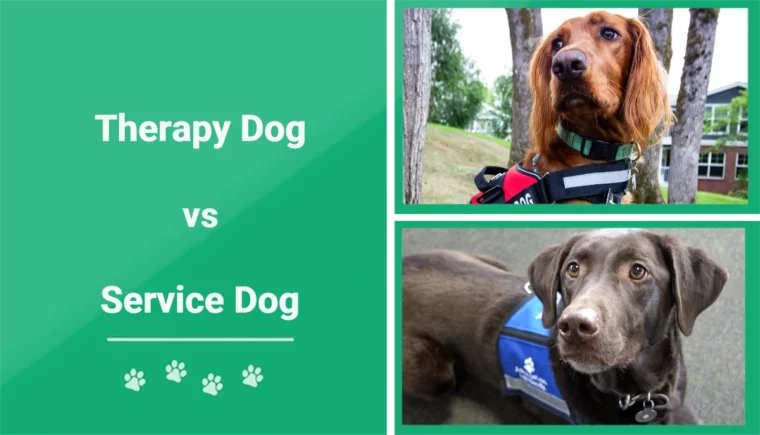
Since ancient times, dogs have aided and collaborated with people in countless tasks, including farming, hunting, protection, and more. The two most impressive examples are therapy and service dogs, which are invaluable in many individuals’ lives thanks to their excellent qualities. However, many people confuse these two types of canines as the same. It’s not true—each of these dogs performs a very distinct function from the others, and the terms aren’t interchangeable.
In this article, we discuss the differences between therapy and service canines, as well as the jobs that each type of dog performs in the lives of those who need them. You’ll know which one is best for you once you’ve finished reading.
Overview of Therapy Dogs
Many people are curious about the first therapy dog, and giving an appropriate answer to that question is quite challenging. There was one candidate from the 1960s1 when a clinical psychologist described therapy dogs to the American Psychological Association. Boris Levinson used his Golden Retriever named Jingles to help children with autism.
Therapy dogs will help you feel better by providing mental support. They are trained to be kind and patient and to accept hugs or petting from strangers. Most of them are categorized as therapeutic visitation animals that reside with their owners. They typically are registered with an organization that will arrange for dogs and owners to visit particular places and interact with the people there.
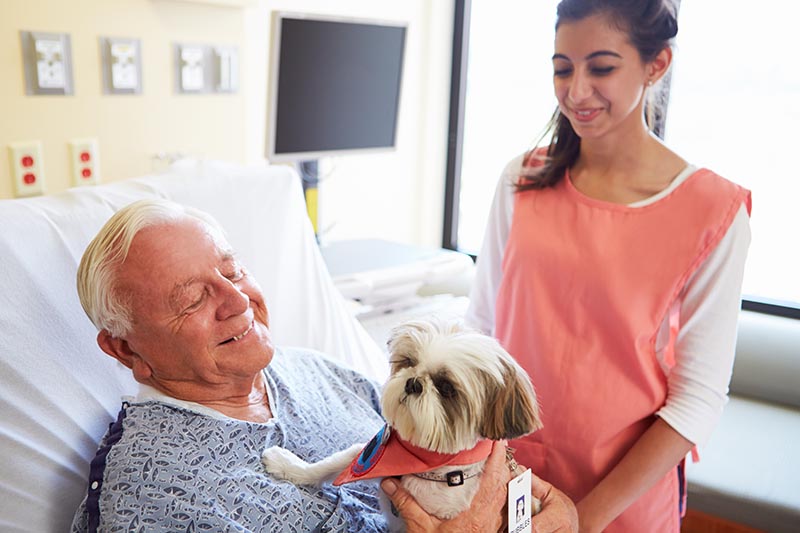
What Does a Therapy Dog Actually Do?
There is no requirement for therapy dogs to perform any specific tasks. They only need to spend time with their owners, get through the difficult moments together, and be there for them.
It has been proven that simply spending time with therapy animals in these kinds of scenarios can help people feel less anxious and depressed. The animals will boost the spirits of those they interact with and make them more willing to engage in their own recovery processes.
Therapy Dog Requirements
A therapy dog must first fulfill some criteria2 to be registered and certified. Although there are a few cases of puppies being used as therapy animals, it’s not very common. The dog needs to be at least a year old. Their handling abilities, manners, and demeanor then have to be evaluated by an identified organization. Then, the organization will commonly observe the animal during actual therapy sessions.
If you’re interested in learning more, you can find out what opportunities are available by searching the internet for the phrase “therapy dog training” and the name of your city or town. You can also contact the facility you have in mind by phone or email to learn about their acceptance procedures.
What Breed of Dog Is Used for Therapy?
With training, any sociable breed of canine can become a therapy dog. Standard Poodles, Golden Retrievers, Labradors, and St. Bernards are the most common large dogs used for this purpose. But if the person and the animal only share a small space, breeds like Mini Poodles and Pomeranians are wise options.
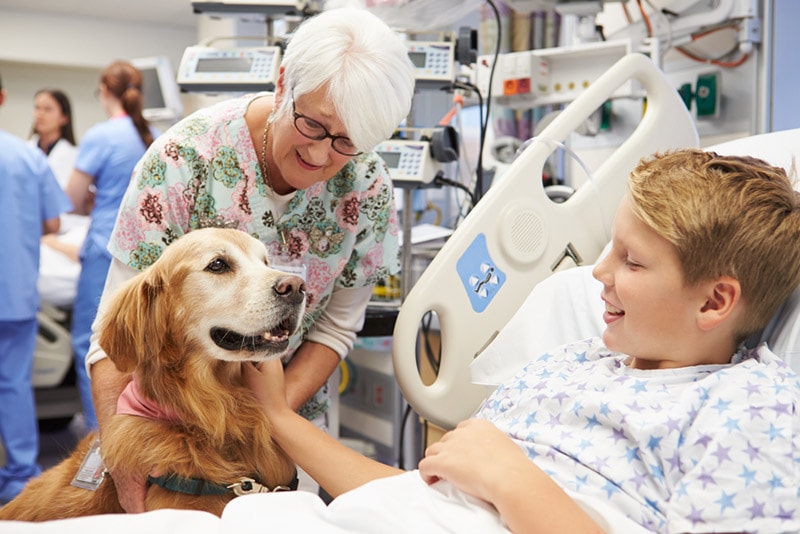
Where Are Therapy Dogs Allowed to Go?
Therapy dogs can visit many settings. These are typically areas where people feel alone, vulnerable, or have a tough time, such as nursing homes, hospitals, special schools, disaster recovery areas, etc.
How To Get a Therapy Dog
Most people are glad to certify their current dog as a therapy animal. Some others decide to purchase one from a reputable breeder or trainer. In addition, you can choose to adopt a pet and later train them to perform therapy work. There is no “right” or “wrong” way to go about it.
Overview of Service Dogs
Service dogs weren’t legally recognized in the United States until the 1990 passage of the ADA. These canines will receive specialized training to carry out tasks and work for individuals with disabilities. A disability is a mental or physical impairment that substantially limits a person’s ability to perform one or more main life activities.
Although police, cadaver, and search-and-rescue canines are all types of working animals, service dogs are very distinct from them. To help one person with something directly linked to their disability, the dog must have received specialized training.
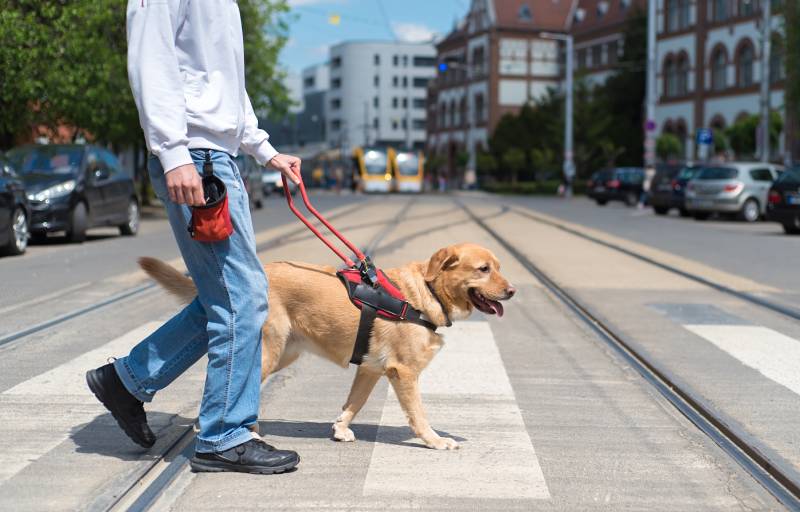
What Does a Service Dog Actually Do?
There are many different kinds of service dogs, and some even have more than one function. Before working with a person, they must complete rigorous training courses. Listed below are a few varieties of service dogs:
Service Dog Requirements
Service dogs must receive special training to do particular tasks that help a person with a disability and must be under the control of a handler. The ADA requires them to be leashed or tethered unless the person’s disability prevents utilizing these devices or these devices get in the way of the animal’s safe, efficient completion of tasks. In these situations, handlers must continue to exert control over the dog using a signal, voice, or other practical management methods.
What Breed of Dog Is Used for Service?
You can find service dogs from very tiny to very large. The dog’s size will allow them to perform their duties comfortably and effectively. A Papillon, for instance, would make a great hearing canine but is inappropriate for pulling a wheelchair.
Labrador Retrievers, Golden Retrievers, and German Shepherds are the breeds most commonly trained as guide pups. Canines with the height and strength to help with mobility include Great Danes, Saint Bernards, and Bernese Mountain Dogs.
Poodles, which come in Standard, Toy, and Miniature types, are exceptionally adaptable. While a large Standard Poodle can learn to turn on lights and carry items, a Toy Poodle can start early scent training sessions to prepare for the job of detecting blood sugar fluctuations.
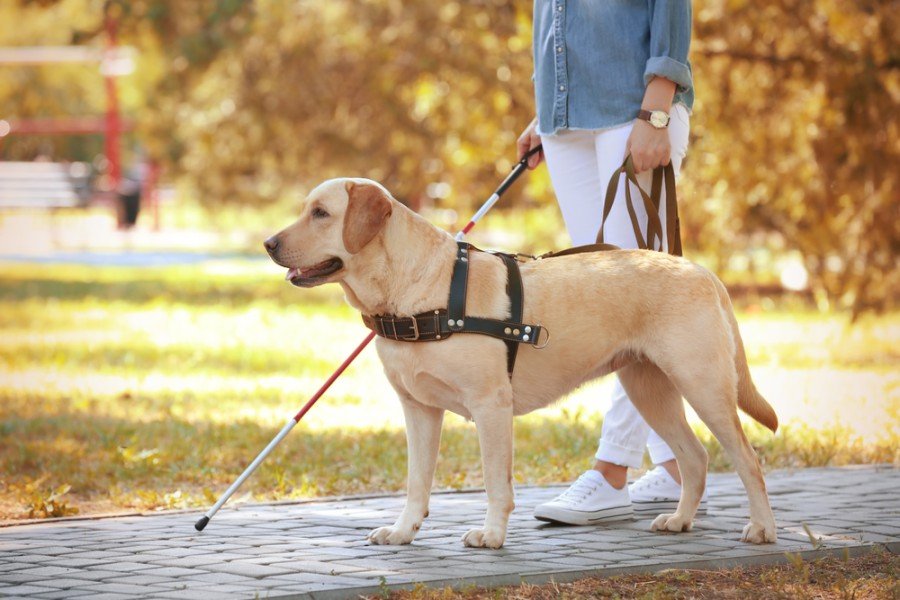
Where Are Service Dogs Allowed to Go?
According to the ADA, people with disabilities have a right to broad public access to their service animals. Unless there are legitimate safety concerns, they can go anywhere open to the public, such as buses, restaurants, stores, and more. However, the handler must ensure the animal is well-groomed and controlled with a leash or harness. Any harm or mess caused by the dog is the owner’s responsibility.
How To Get a Service Dog
People with physical or emotional health conditions can live much more easily with the help of service animals. That’s why how to get a service dog is a common question nowadays.
The easiest way for most people to adopt a service pup is through an identified organization. Fortunately, there are many who specialize in training service dogs all over the United States. They will train a canine for a particular job, such as acting as a psychiatric service dog, a seeing-eye dog, or other types.
Some organizations give free service animals to people with disabilities, while others might offer financial aid to those who need a service dog but cannot afford one. Some others may charge a fee for a trained canine.
Can Police Ask for Service Dog Proof?
The police are not allowed to request documentation of service animals under the law. If a police officer stops you and asks for service dog proof, politely respond that the ADA does not require that the dog has any identification or certification. You don’t have to, but you can give them details about your canine if you want to.
What People Can Ask You About Your Service Dog
Staff members may only ask about the following two things if it’s unclear whether the dog is a service animal: (1) Is the dog a service animal needed due to a disability? (2) What tasks has the dog been taught to perform? As mentioned above, staff members are prohibited from requesting documentation about the canine, asking them to perform duties, or inquiring about the person’s disability. These animals also don’t need to wear an ID tag, a vest, or a specific harness.
Conclusion
While service and therapy dogs improve many people’s lives, they are not the same type, and the distinction is not a simple question of semantics. More specifically, it related to their responsibilities, access privileges, and required training. Hopefully, this article has shed some light on the differences between these two kinds of dogs and helped you decide which is right for you.
See Also:
- Allergy-Detection Service Dogs: What They Are & What They Do
- Service vs. Therapy vs. Emotional Support Dog: The Main Differences
Featured Image Credit: Top – Ryan Stone, Unsplash | Bottom – Shine Caramia, Shutterstock








